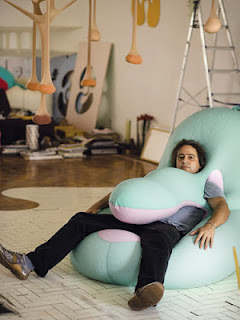 |
| image 02. |
We began with a simple exercise [see image 03.] and tried to imagine how the object could move, by stripping away the usual normality and understanding of what the object was and giving it an entirely new function it was easy to imagine it coming to life. We then did another exercise where we collectively 'married' the objects [see image 02.] to gain a better understanding of how quickly we can associate objects as living by simply initiating our imaginative skills.
We discussed how the notion of 'play' is key within object theatre. Sean talked about how when a child plays with objects they feel it and even taste it to understand the quality of what they are playing with - as adults, we tend to lose this, so by exercising our minds to simply 'play' it releases the element of fun that adulthood can relentlessly steal from us. I feel that through object theatre we can gain the positive, energetic and care-free mind of the child. *This particular part of the conversation reminded me of 'Poetics of Space' by philosopher Gaston Bachelard who talked about and explored the idea of our home being the centre of our universe, particularly looking at childhood and the importance of play.
 |
| image 03. |
























